I put this together because simple hairstyles can make a big difference for people with thin hair and a round face. I know how it feels when hair looks flat and loses its bounce just when you need it to shine. This guide bundles 25 hairstyles designed to add lift, movement, and lasting fullness without hours of work. You’ll find looks that feel easy, practical, and ready to wear in real life.
Who it’s for is clear: if you have thin hair and a round face, this ones is for you. If you care about volume, balance, and styles that flatter your features without a lot of fuss, you’ll find ideas you can actually pull off. Whether you love curls, waves, or a smooth, straight finish, these options fit real hair and real mornings.
What you’ll get is practical and doable. I’ve put together 25 hairstyles with notes on the best cuts, how to style at home, and quick tweaks for your hair texture. You’ll learn how to ask for layers that lift the crown, how to create soft waves, and where to place bangs for balance. From short bobs to longer layers, every idea is chosen to add volume without weighing hair down.
Here is why these styles work for round faces. Face-framing layers, crown lift, and side-swept bangs help guide the eye upward and add the illusion of length. A textured finish keeps strands lively instead of flat. I include simple, real-life steps you can try at home, like using a round brush while you dry and letting movement carry the look.
Not every idea fits every head of fine hair, and that’s okay. You may need a quick trim to tailor a cut to you. Start with a consult and bring photos of looks you like. For tools, keep a light mousse, a soft-hold product, and a round curling iron or diffuser handy. Small choices here make a big difference in how full your hair looks all day.
Take a look at the full list and pick one idea to try this week. This post aims to give you real, doable options that feel fresh yet familiar. Save a few favorites and bring them to your stylist, and you’ll be closer to a fuller look that suits a round face and fine hair.
1. The Layered Bob
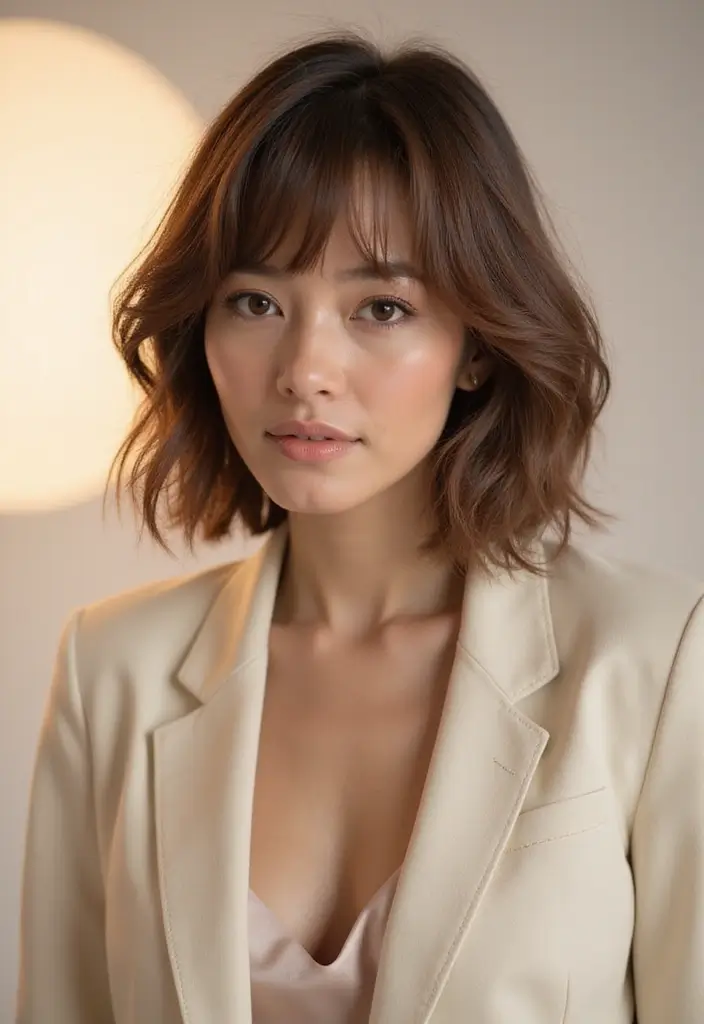
If your thin hair sits flat and your round face looks a bit softer, a layered bob can add real fullness. Layering creates movement and texture, so strands feel lighter. Hair looks thicker at the crown and bounces with life. The aim is soft, airy layers that lift without weighing you down.
For a round face, choose a chin-length cut. This length helps draw your eye downward, creating the illusion of length. A touch of natural wave boosts volume. Side-swept bangs soften the cheeks and add a polished touch without masking your face shape. With the right styling, you’ll feel taller and more balanced.
Here is how to make it work:
– Start with clean, damp hair.
– Apply a volumizing mousse from roots to midlength to build lift.
– Blow-dry with a round brush, focusing on the crown to push hair upward.
– Keep layers light and avoid heavy gels that weigh hair down.
– Add a gentle wave at the ends with a wand or curling iron for texture that reads as fullness.
– Finish with a light mist or balm for softness rather than stiffness.
Tip: Use a volumizing mousse before blow-drying to create bounce and body.
Bonus: Brighten the look with subtle highlights to add extra dimension and depth.
2. Shaggy Lob
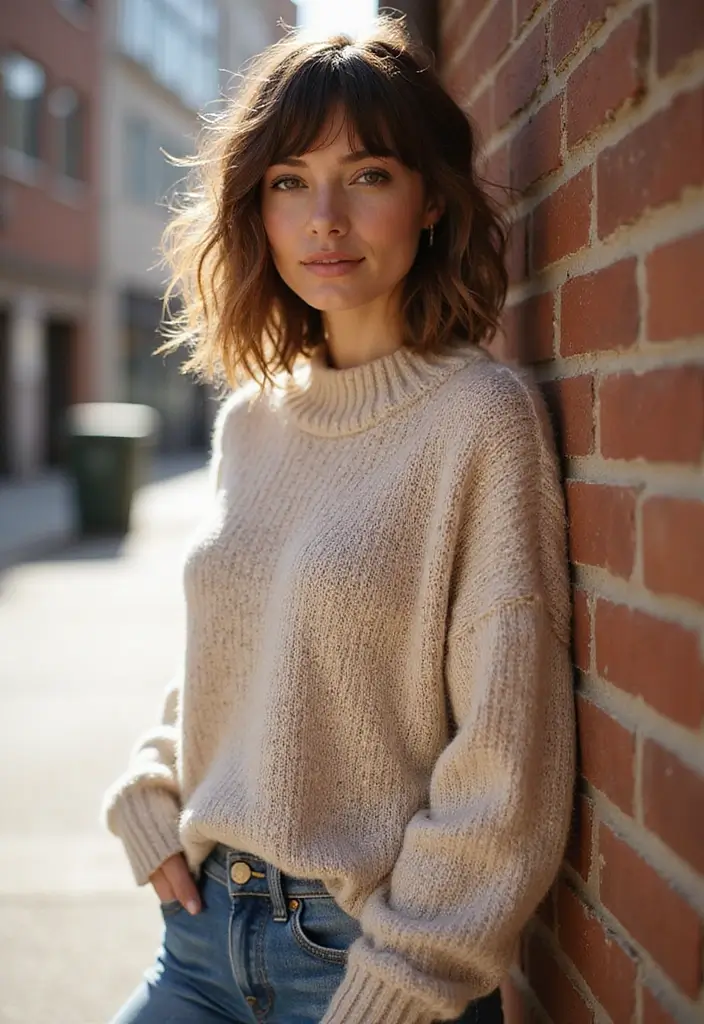
If you have thin hair and a round face, the shaggy lob can add real fullness. It stays at shoulder length with rough, uneven layers that bring movement and depth.
Here is why it helps: the jagged layers break up the round silhouette and create shadow that makes each strand look thicker. It also keeps your hair easy to style, so you can go from casual to dressed up without lots of work.
– 1) Ask for a shoulder-length cut with several long, face-framing pieces that end below the chin.
– 2) Keep the top a touch longer to add height at the crown and avoid a flat look.
– 3) Choose a messy finish and use a light texturizing spray to wake up the ends.
– 4) Style the ends with a curling wand to form soft waves, focusing on the tips for a breezy feel.
– 5) Go light at the roots with mousse or dry shampoo for lift, then finish with a tiny bit of shine spray.
Here is what to expect: the look shifts the vibe of your hair from sparse to lively. It works for everyday days and can be dressed up for events.
Next steps: take this plan to your stylist or try small tweaks at home. You can change wave size by adjust ing the wand, or swap in sea salt spray on humid days. With the right cut and a simple routine, your hair can look fuller, healthier, and easy to manage.
3. Long Soft Bangs
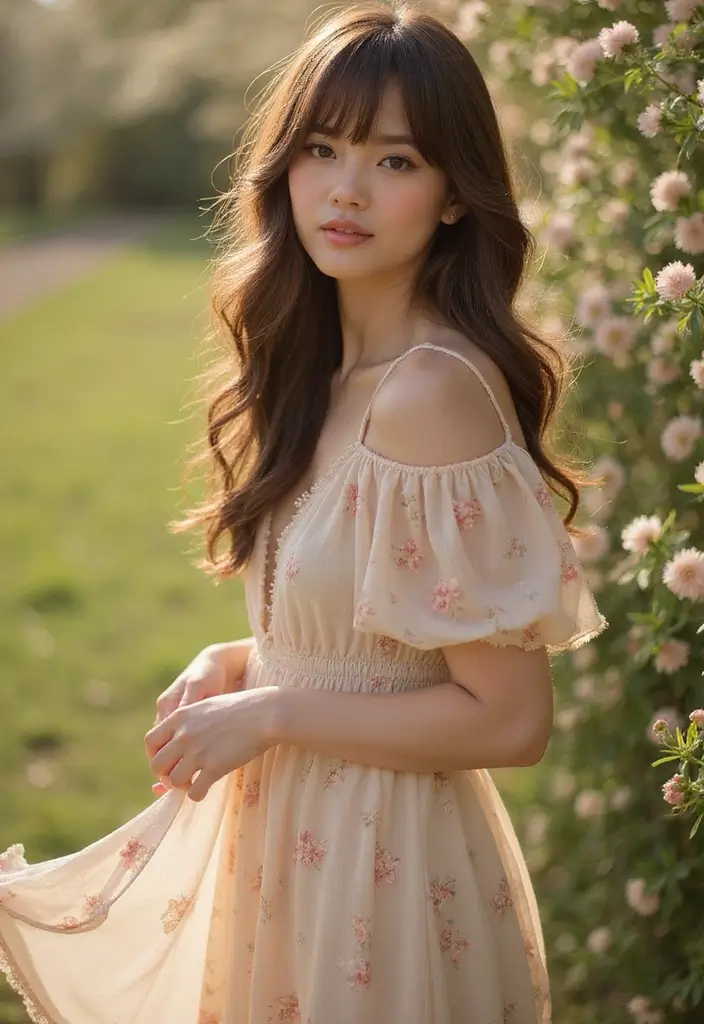
Struggling with a round face and thin hair? Long soft bangs can help you add fullness without losing length. These bangs start around the brow and softly flow into longer layers. They create an elegant silhouette that flatters your features.
Style them straight for a polished look. Or tousle them a bit for a relaxed vibe. The key is how you part them. Tip: Part the bangs at the center or slightly off center to stretch your face. Blunt cuts at the fringe can make a round face look wider. This balance helps your eyes stand out and your cheeks soften.
This style works with all hair types. Keep the rest of your hair healthy and shiny to boost the look.
– Have your stylist cut a long fringe that blends into the rest of your hair.
– Use soft, tapered ends for a natural blend.
– Blow-dry with a round brush to lift the fringe at the roots.
– Apply a light leave-in or styling cream to smooth frizz without weighing hair down.
– Part in the center or slightly off center to lengthen the face.
– Schedule trims every 6 to 8 weeks to keep the shape.
With practice, you can switch looks fast and keep a fuller, flattering hairline.
4. Textured Pixie Cut
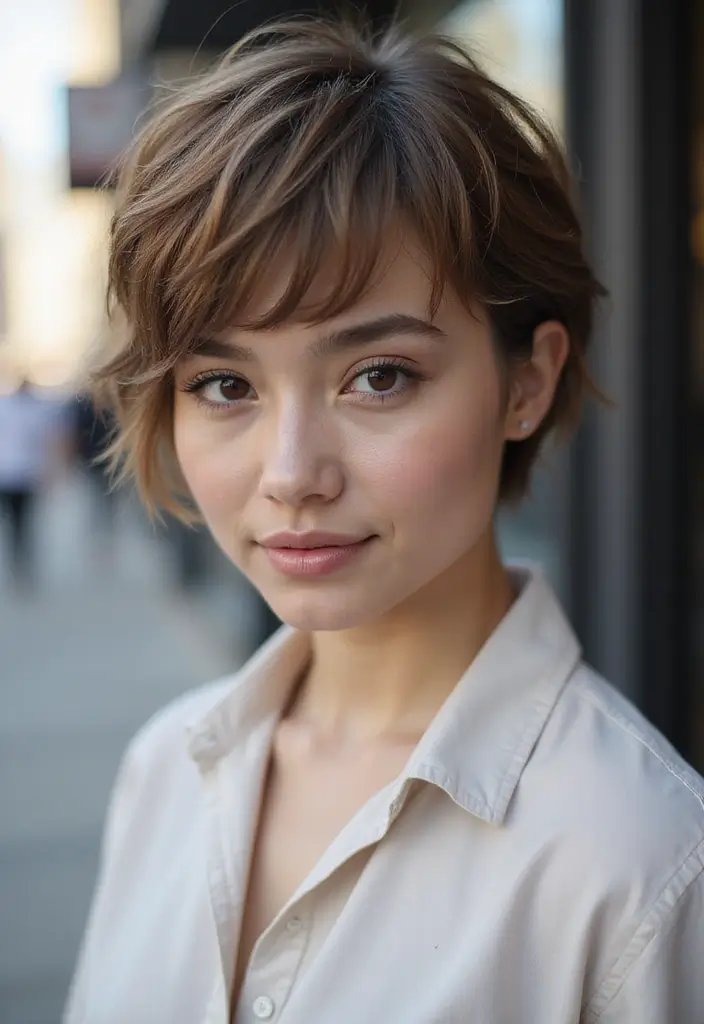
If your hair is thin and your face is round, you may fear a short cut will look flat. A textured pixie cut changes that. It is short, fresh, and full of character. Layered relief at the crown adds lift and makes your hair feel fuller.
Why it suits round faces
– Layered crown adds height without piling on bulk at the sides
– A short back keeps the head balanced for a flattering silhouette
– A light fringe or side sweep softens the jawline
How to achieve it
– Ask for soft, choppy layers through the crown and sides
– Leave extra length on top so texture can be worked in
– Keep styling light with a pomade or wax
– Use your fingers to shape a natural, lived-in look
Simple styling ideas
– Dry with a round brush to lift the crown
– Twist small sections as you apply product for lasting texture
– Try a textured fringe to soften a wide forehead
Maintenance and limits
– Schedule trims every 4 to 6 weeks
– Works best with thin or fine hair; very thick locks may need extra texturing
Next steps
Bring a few photos to your stylist and compare versions to find what flatters your face the most.
5. Blunt Cut with Bangs
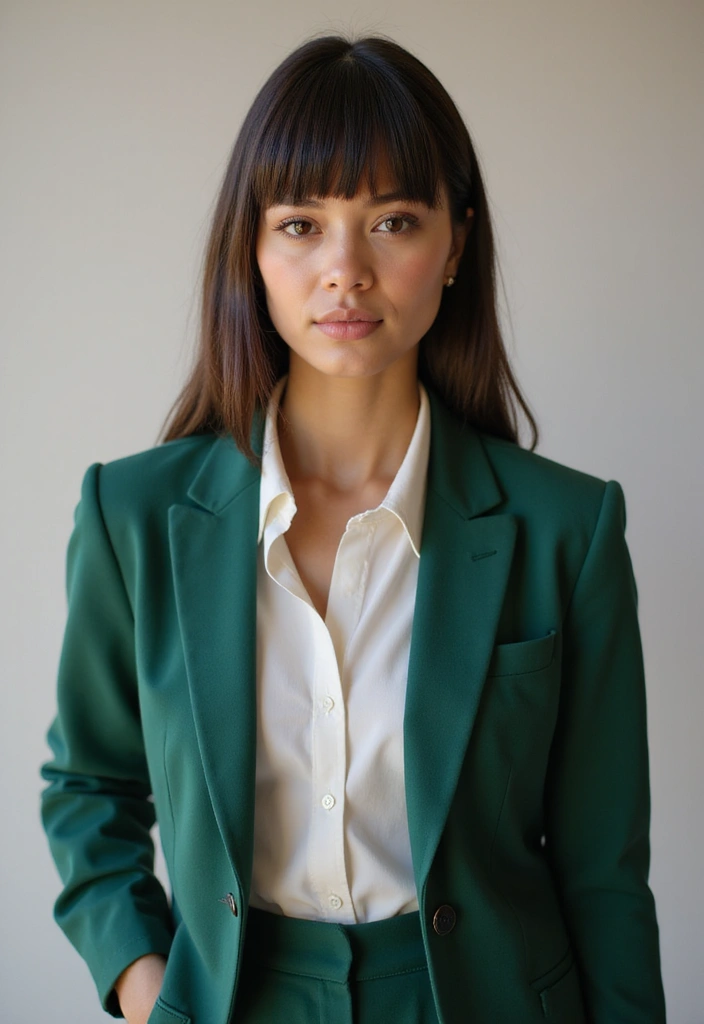
If you have a round face and thin hair, a blunt cut with bangs helps your hair feel fuller. A shoulder-length edge adds weight at the ends, so strands look thicker. Straight-across bangs frame your eyes and lift your look. Here is why this style works for you.
Two practical options
– Shoulder-length blunt cut with bangs or a blunt haircut with bangs gives a clean, powerful line.
– Blunt-cut bangs that sit at the brow shape a strong frame around your eyes.
Next steps for styling
– Start with clean hair and apply a heat protectant spray to guard against heat.
– Blow-dry with a round brush to lift the crown and push volume toward the front.
– For a straight finish, glide a flat iron along the blunt edge in small sections.
– For texture, curl the ends with a large-barrel wand and then softly break the waves with your fingers.
Care and maintenance
– Use a lightweight conditioner and a leave-in spray to keep ends smooth without weighing hair down.
– Finish with a light shine spray to avoid dullness.
– Trim every 6 to 8 weeks to keep the edge crisp.
The result is a frame that highlights your eyes, adds fullness, and stays easy to manage.
6. Wavy Shoulder-Length Hair

If your thin hair looks flat on a round face, you want fullness that lasts. Wavy shoulder-length hair can give you that lift. The movement adds texture and makes your strands feel thicker.
Here is why waves help. They create body from roots to ends. The shape of the waves makes light catch different layers, which makes your hair look fuller.
Let’s break it down with practical steps you can follow now.
– Step 1: Start with a volumizing shampoo and a lightweight conditioner. Apply conditioner only from mid lengths to ends.
– Step 2: Dry with a round brush. Lift the roots as you dry to push hair away from the scalp.
– Step 3: Create loose waves with a curling iron. Take 1-inch sections and wrap them around a barrel for about 8 to 10 seconds. Leave ends a bit out for a natural bend.
– Step 4: Gently run your fingers through the waves. Soften the shape to boost fullness without stiffness.
– Step 5: Tip: Use a light-hold hairspray or a soft texturizing spray at the crown to lock in volume without weighing hair down.
– Step 6: Add subtle highlights or lighter streaks. A few face-framing pieces can brighten your look and add dimension.
This style is versatile for day or night. For a quick switch, fluff the crown slightly, or smooth the ends for a sleeker vibe. If your hair falls flat fast, try a touch of dry shampoo at the roots after the wave is set.
Next steps: grab a curling iron, a light spray, and try this on your next wash day. You’ll enjoy visible fullness with a clean, easy routine.
7. Half-Up Half-Down
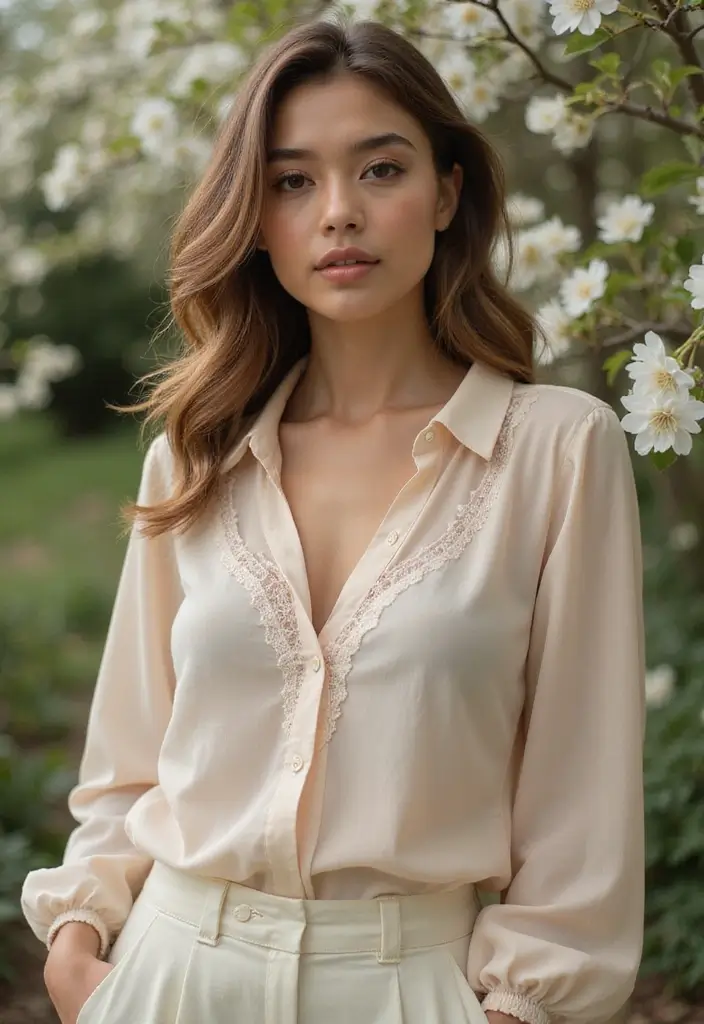
This style gives you length and lift, ideal for thin hair on a round face. It shows your ends while the crown feels fuller.
Here is why it works: pulling half the hair up adds height at the crown, and the remaining strands frame your cheeks.
– Start with clean, dry hair and add texture. A light root-boost spray gives grip without stiffness.
– Gently tease the crown in small sections. Lift the roots just enough for natural fullness.
– Smooth the top and pin the half-up with a clip or slim scrunchie. A tiny clip keeps the look neat.
– Leave a few face-framing strands free. Try soft bangs or wispy pieces to shape your face.
– For movement, curl the bottom in loose waves. It adds softness without weighing hair down.
– Finish with a light, flexible spray to hold lift all day. Skip heavy gels.
Next steps: try a side part to mix things up, and adjust how much hair you pull up to balance your features.
With practice, you will nail the move in minutes. The trick is keeping the top smooth and the bottom soft. This look stays comfy for school days or work days. Give it a try this week.
Unlock the secret to stunning volume! A half-up half-down style not only adds height but also beautifully frames your round face, making thin hair look effortlessly full.
8. Beachy Waves
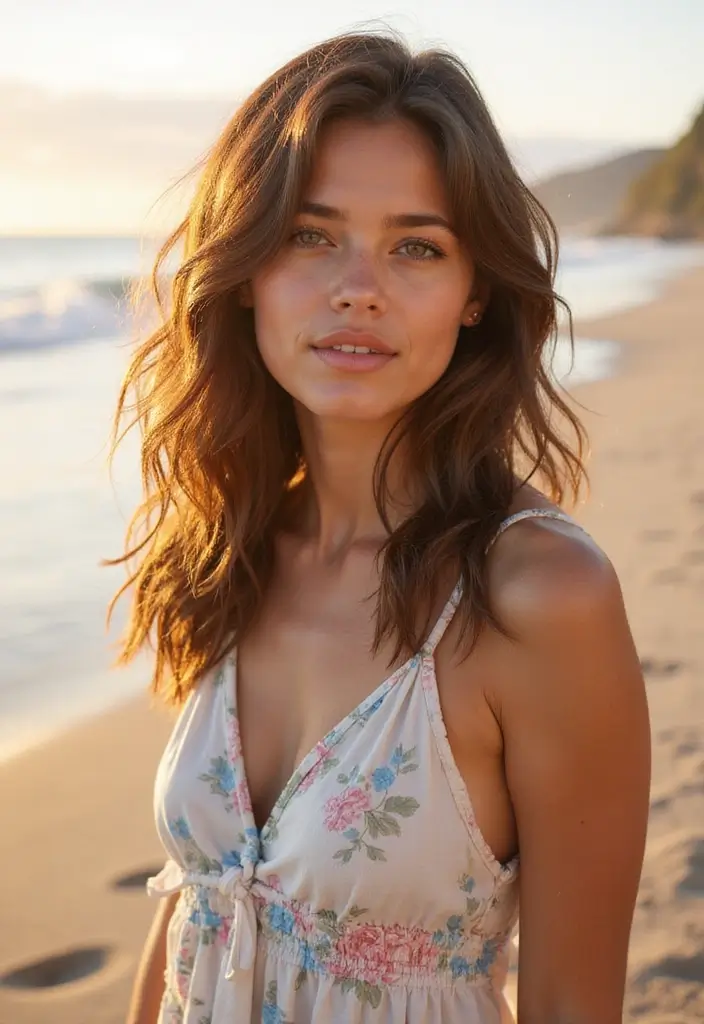
Struggling to add fullness to thin hair while keeping your round face balanced? Beachy waves are your friend. They boost volume and soften the edges of your face. The look stays easy, not fussy, and it works for many occasions.
Here is how to get it right.
– Prep damp hair with a sea salt spray. From roots to ends, mist it evenly. Then scrunch with your hands. Let the texture build in naturally.
– Create loose waves. Wrap sections around a curling wand for a few seconds each. Keep the curls soft and loose. Alternate the direction of the wrap so the waves look natural.
– Break up the waves. Run your fingers through your hair to loosen the set. Tilt your head slightly and lift at the crown to add height where your face needs balance.
– Set with a light touch. Use a texture spray or a tiny amount of lightweight mousse. Avoid heavy products that weigh hair down and hide the texture.
– Finish and style. Comb through with your fingers for a relaxed, beachy vibe. If you want more polish, sweep the waves to one side and pin a small piece behind your ear.
Tip: For extra volume, dry the crown with a diffuser on low heat. This keeps the shape longer and keeps the look fresh all day.
Next steps: adjust the amount of product to your thin hair. Less is more, and soft, uneven waves often read as more full.
9. Crimped Hair
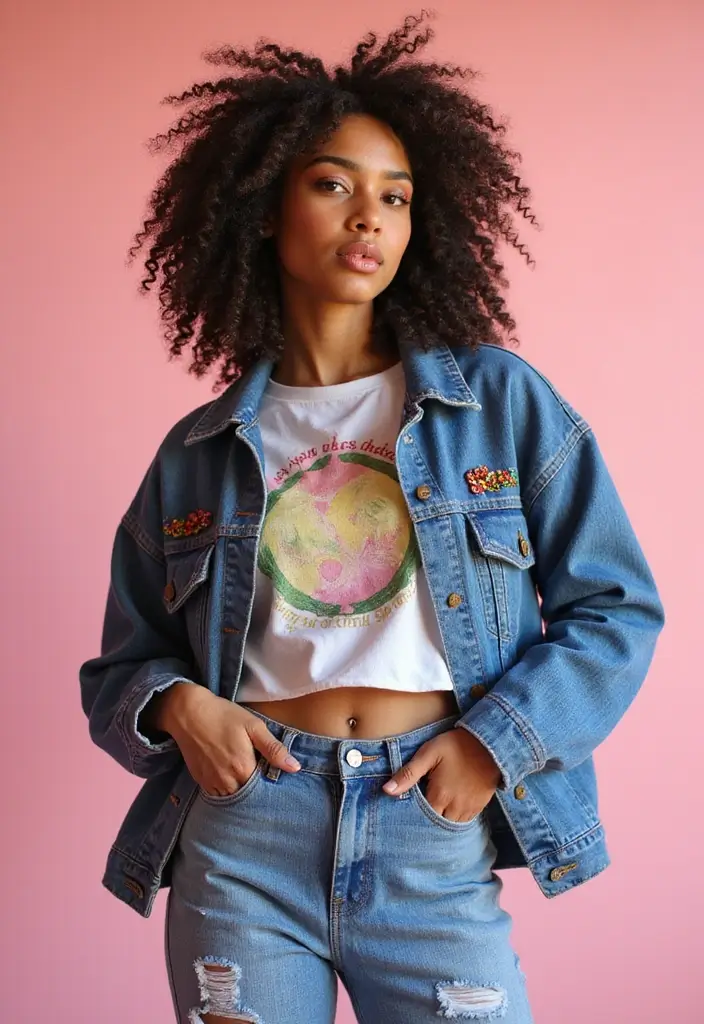
Thin hair on a round face can feel flat. A crimped hairstyle adds texture and height. It makes your hair look fuller without demanding a big change.
Here is why crimped hair helps:
– It texture catches light and hides limp strands.
– The crimp pattern creates vertical lines that can visually elongate the face.
– When you crimp from the mid-length to the ends, you keep crown volume soft while adding length.
Next steps for a safe, lasting style:
– Start with a heat protectant spray. Apply it from roots to ends.
– Pick a crimping tool with even plates. Set a low to medium heat so you don’t stress thin hair.
– Section your hair. Clamp small pieces from mid-length down to the ends. Hold for a couple of seconds and release.
– For a natural look, run your fingers through the texture to loosen it a bit. This gives a softer finish.
– Finish with a light hold spray or a texturizing mist to keep shape without stiffness.
Styling options:
– Pair the crimp with a simple braid or a low ponytail for extra movement.
– Add bold accessories or a bright lip shade to draw attention to your look.
– If you want more lift at the crown, use a tiny amount of root lift spray. Apply sparingly.
Care tips:
– Give your hair breaks between heat sessions.
– Use a gentle shampoo and conditioner to keep texture healthy.
10. Side-Swept Waves

If you have thin hair and a round face, you want a look that adds length without weighing you down. Side-swept waves do just that. They draw the eye diagonally and give the illusion of a longer, slimmer silhouette. This style feels simple to wear.
Here is why it works: soft waves create vertical movement. Sweeping them to one side adds asymmetry, which breaks up round edges.
How to pull it off:
– Prep with a lightweight smoothing product to tame frizz without dulling your shine.
– Blow-dry with a round brush to lift roots for volume.
– Create waves with a 1.5-inch curling iron. Curl sections away from your face and keep ends smooth.
– Flip hair to one side and brush lightly for a single sweep.
– Pin a small piece behind the ear for polish.
Tip: Use a large barrel curling iron and apply a smoothing serum to keep the waves looking polished and shiny.
This look shines at special events or a night out, when you want eyes on you. If your hair is very fine, add a touch of texture spray at the roots to hold volume.
Next steps: practice a few times so the swoop sits right and you feel confident.
11. Curly Bangs
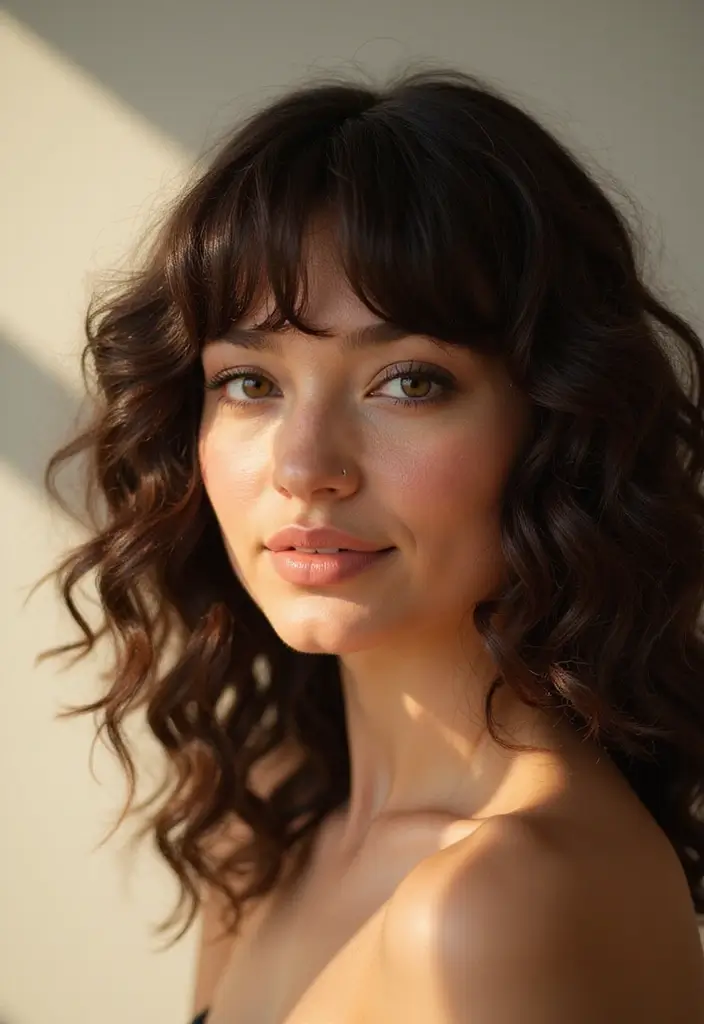
If you have a thin mane and a round face, curly bangs can be your secret to more fullness. They add texture without making hair feel heavy. The trick is to keep the curls soft and not let them hide your features. This small change can open up the face and draw attention to your eyes.
Here is why curly bangs work on round faces. They create movement at the sides of your face and help balance width with length. Loose curls near the forehead feel light and modern, not bulky.
– Keep the curls loose and bouncy so they frame your eyes without crowding your cheeks.
– Let the curls sit above your eyebrows, not over them, so your face stays open.
– Tip: Use a curl-enhancing cream to keep definition and cut frizz for you.
– Scrunch from the ends toward the roots to avoid stiffness for you.
– Diffuse on low heat or let hair air dry for natural texture for you.
– Pair curly bangs with a longer cut to balance fullness and create a chic line for you.
Two clear styling options.
– With a longer cut, curls blend into the length for a seamless look you can wear daily.
– With shoulder-length hair, you get a playful vibe and easy shaping you can trust.
Care and maintenance tips: avoid heavy products that weigh your hair down. Sleep on a satin pillowcase to reduce frizz. A lightweight leave-in helps curls bounce all day for you.
12. Braided Crown
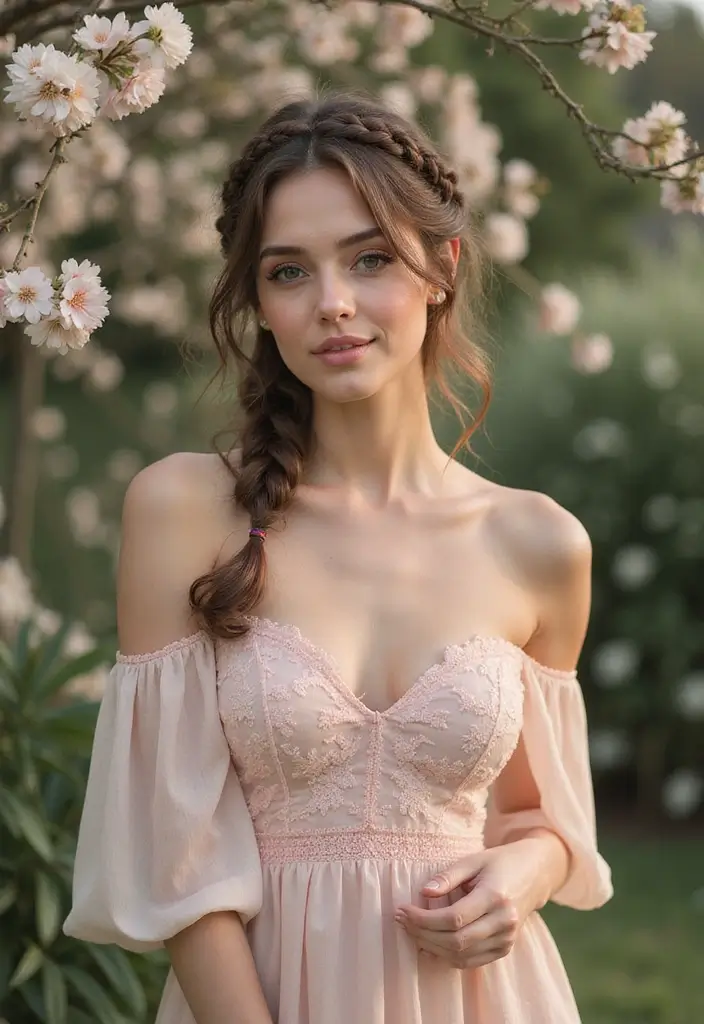
If you have thin hair and a round face, you want a look that adds fullness without weighing you down. A braided crown fits. It’s polished and romantic, and easy to wear for weddings, proms, or any formal event.
Here is why it works for a round face. Braids add texture and lift. They wrap around your head, creating the look of more volume and a higher crown.
Next steps:
– Start with clean, dry hair. A light texturizing spray helps thin hair grip the braid.
– Part your hair where you want the crown to sit, either in the center or slightly to the side.
– Take small sections from the front on each side and braid toward the back.
– Bring the braids around to meet at the back and pin them along the crown.
– Gently loosen the braids after pinning to create a fuller, softer look.
– Choose between a fishtail braid or a classic three-strand braid based on your hair texture and how much time you want to spend.
– Finish with a light mist of hairspray to hold the shape.
– For extra hold in fine hair, apply a touch of dry shampoo at the roots before you start and tuck loose hairs with a pin as needed.
13. Soft Updo
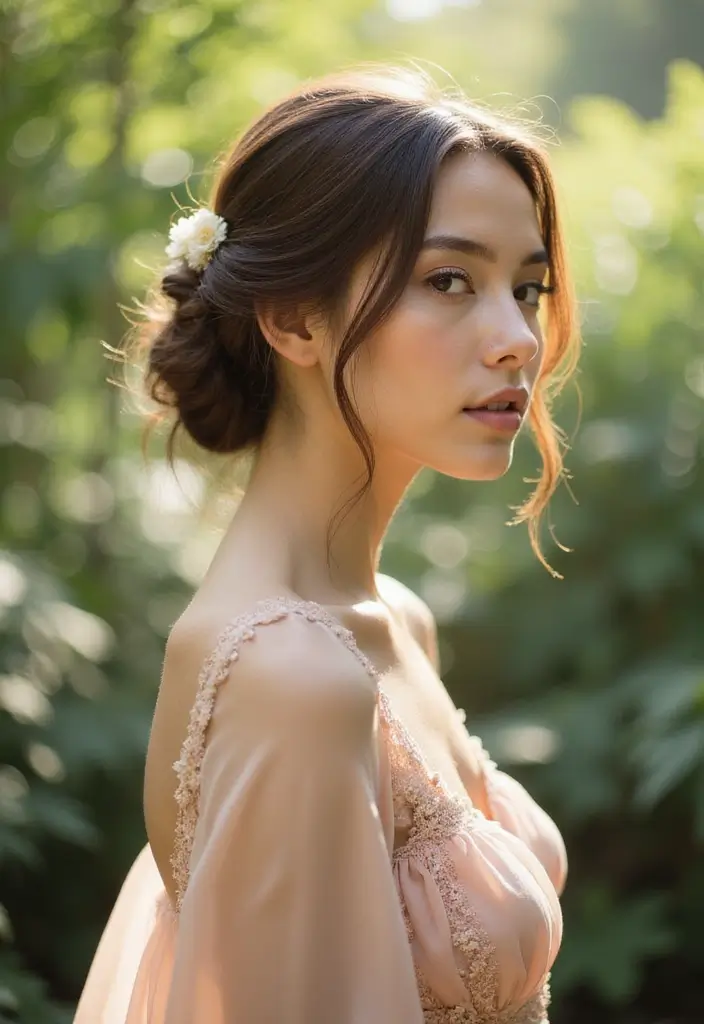
A soft updo helps round faces with thin hair by adding height at the crown. You lift the roots and let the rest fall softly for balance. Your face looks longer.
What you’ll need
– volumizing powder
– a fine-tooth comb
– bobby pins
– a light hair spray
– elastic
Here is how to do it
– Start with clean, dry hair. Apply a dab of mousse for grip.
– Lift the crown. Sprinkle powder at the roots and lift with your fingers.
– Tease the top for height, then smooth the outer layer to keep a soft line.
– Gather hair into a loose bun or chignon at the back or off-center. Pin in place, leaving face-framing strands.
– Pull a few wisps around the face for a frame. Mist to set.
– Want more lift? Add a touch more powder at the crown and tease gently.
– If your hair is very fine, try a light texturizing spray after setting.
– It stays fresh all day.
– Curl the ends for a softer, shinier finish too.
14. Faux Hawk

If you have thin hair and a round face, you may think volume is hard to pull off. The faux hawk can change that. It adds height when you need it and keeps the sides tidy. It looks bold yet simple enough for everyday wear. Here is how you pull it off so it suits you.
– Center peak for length: A tall crown makes your head look longer and helps balance a round jaw. Keep the sides shorter so the top stands out.
– Prep and grip: On damp hair, work in a light mousse or grip-friendly cream. This gives texture without weighing you down.
– Lift while you dry: Use a round brush and a blow dryer. Push the crown upward as you dry. Don’t let the center droop.
– Shape with the tool: When your hair is dry, shape the peak with your fingers. A dab of strong gel or wax holds the line without stiffness.
– Keep sides neat: Trim the sides shorter than the top. This contrast makes the faux hawk read clean and sharp.
– Finish with spray: A light mist of hairspray keeps the look from sagging all night. It stays flexible enough to touch up.
– Add drama with color: Subtle highlights add depth and let the peak pop against your hair.
– Practice makes progress: Start with a small lift, then test a higher peak for night events. Adjust until you feel confident.
15. Curtain Bangs

Struggling with a thin mane on a round face? Curtain bangs can help. They soften your curves and frame your eyes, creating the look of more fullness without heavy layers.
Here is why curtain bangs work for round faces with thin hair:
– They draw attention down and out, adding vertical lines that slim the cheeks.
– The soft, face-framing shape smooths the outline, not the hairline.
– They blend with longer hair for a balanced silhouette.
– They feel light and breezy, so you get a chic vibe without effort.
How to make curtain bangs fit you
– Length matters: keep the bangs a bit longer, grazing the cheekbone or just past the brows. This avoids a heavy block and helps the eye travel down.
– Texture helps: wash and dry with a round brush for volume, or let natural waves soften the look.
– Styling basics: part in the middle and sweep outward. Use a light serum or a mousse to hold the bend without weighing hair down.
– For fine hair: skip thick products. A dab of lightweight spray adds lift at the roots.
– Maintenance: trim every 6 to 8 weeks to keep the shape fresh.
Next steps
Try a soft, longer curtain fringe with a gentle bend. Pair it with shoulder-length layers to maximize fullness.
16. Slicked-Back Style
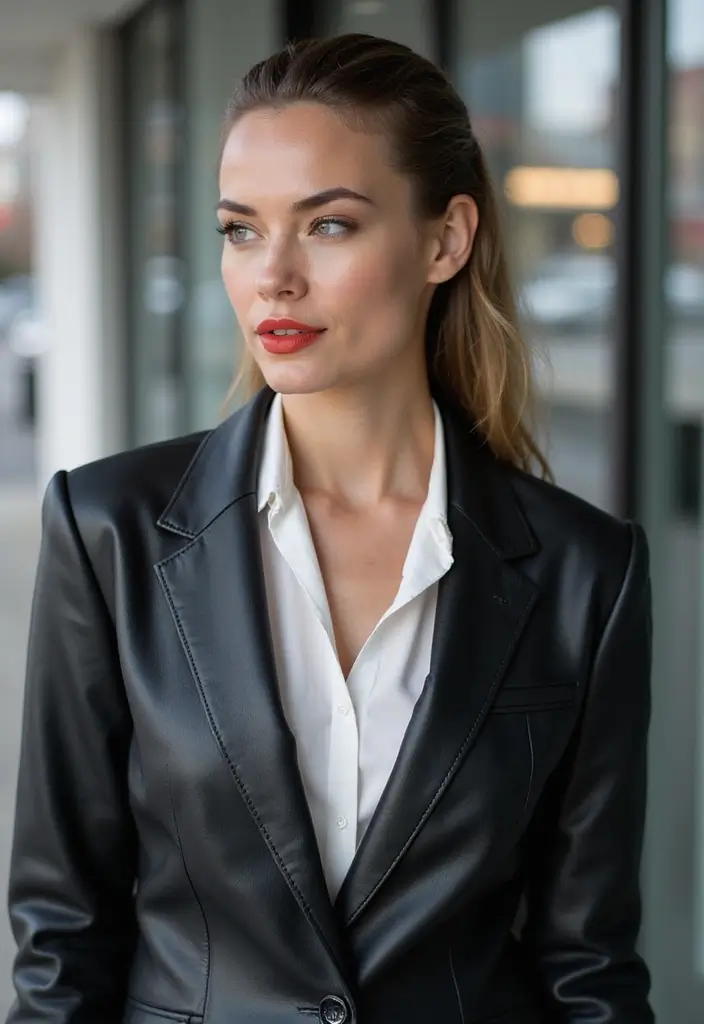
If you have thin hair and a round face, you might think a slicked-back style won’t work. Think again. This look can add real fullness and frame your features with clean lines. It shines with longer hair and gives your face a little more length. Here is how you pull it off.
Here is why it helps. Lifting the hair at the crown adds height. Smoothing the sides keeps the shape neat. The result is a confident, polished vibe from day to night.
– What you’ll need
– Lightweight gel or pomade
– Fine-tooth comb or brush
– Clean towel and a blow-dryer on low heat
– Light hairspray for a soft hold
– Steps to style
1) Start with clean, dry hair. This helps the product grip and stay in place.
2) Rub a pea-sized amount of product between your palms. Warmth helps it spread evenly.
3) Brush hair straight back from the crown toward the nape. Keep the roots light to avoid a heavy look.
4) Lift a bit at the crown with your fingers. A gentle bump adds shape and fullness.
5) Blow-dry on low heat while guiding with the comb. This sets the lift without shrinking it.
6) Finish with a light spritz near the crown if you need extra hold. Avoid coating the roots.
– Next steps If you want a day look, try a matte pomade. For a night out, a light gel gives a sleek shine without feeling stiff.
For best results, work with your natural hair texture and keep the sides clean. With practice, this slicked-back style can add noticeable fullness to a round face and keep you looking sharp.
17. Voluminous Updo with Bangs

If you want height and fullness with thin hair, try a voluminous updo with bangs. It frames a round face and keeps hair looking full.
Here is why it works: lifting the crown adds length to the face, and bangs draw the eye upward.
Next steps:
1) Mist hair with a light flexible spray. Comb through to remove tangles.
2) Backcomb the crown once or twice for lift. Smooth the top.
3) Gather the rest into a bun or low twist at the back. Pin securely in a crisscross pattern.
4) Style the bangs. Side sweep or straight across, then pin lightly to frame the eyes.
5) Finish with a soft spray. Pick a finish that stays flexible.
6) Add a small accessory for charm. A pin or tiny flower brightens the look.
Want more height? Tease a bit more at the crown or pull a few wisps loose for soft texture.
To keep it lasting all day, carry a slim pack of pins and a small bottle of spray in your bag.
If your hair is very fine, use small amounts of product and tease the crown only.
With practice, this updo can take about 10 minutes. It looks elegant, easy, and works for events or daily wear.
18. Vintage Waves
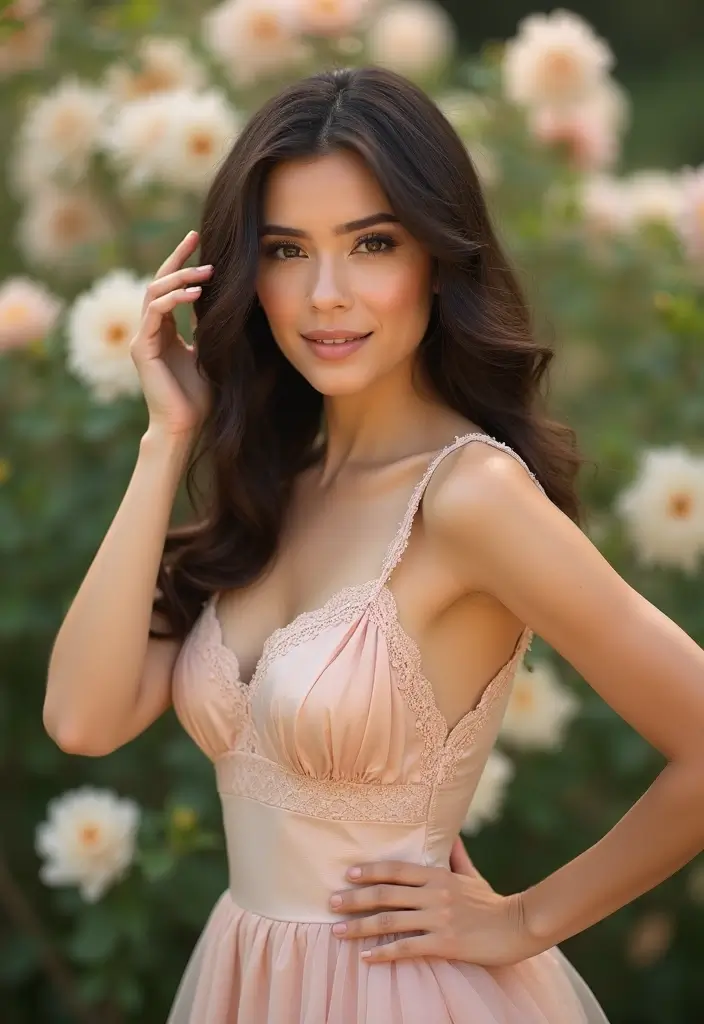
Thin hair on a round face can look flat. Vintage waves add fullness and soften angles. They frame your features with touchable, glamorous texture.
Here is why this style helps. Loose waves add volume at the crown. A side part creates length visually. A little shine makes the look feel polished.
– Step 1: Prep your hair. Apply a light mousse at the roots. Blow dry with your head tilted back to lift the crown. Use a heat protectant.
– Step 2: Curl with a large barrel iron. Take 1 to 2 inch sections. Wrap away from your face. Hold a few seconds. Don’t curl tight. Let the waves stay soft.
– Step 3: Break up the curl. Gently brush with a wide comb to loosen. Pinch the ends for a gentle vintage bend. Sweep the hair to one side for drama.
– Step 4: Set and shine. Use a light hold spray to keep waves in place. Tip: Rub a drop of shine serum through the lengths for gloss. This keeps the look bright without weighing hair down.
Maintenance tip: If your hair falls flat as the day goes on, tease the crown barely before you head out, then re-spray lightly.
Next steps: Practice with a dry run. Adjust the part to suit your face. Try different side angles to find what flatters you most.
19. Messy Bun

If you have thin hair and a round face, you want a style that adds height and makes your hair look full. A messy bun fits that goal. It stays casual, yet it lifts the crown. It adds volume around the sides to frame your features softly.
Tip: Use a texturizing spray to help give grip while styling.
Here is how to get the full look.
1) Prep hair with texturizing spray or dry shampoo at the roots to add grip.
2) Gather hair high on the crown to create lift.
3) Tie it with a thin elastic to form a base.
4) Twist the length loosely so it stays soft.
5) Wrap the twist into a bun and secure with a few pins.
6) Leave a few strands loose around the face to frame your features.
7) Pin the bun snug but not stiff for a soft look.
8) Gently tug on the bun or edges to add volume.
9) Finish with a light hold spray to keep it in place.
10) Add a clip or scarf for a polished finish.
This style works well for thin hair on round faces. If you want more height, start with a higher bun. Keep the vibe imperfect on purpose. This adds texture and makes the look feel natural and modern.
A messy bun is more than just a hairstyle; it’s a statement! Perfect for thin hair and round faces, it lifts your look while adding that desired volume around the sides. Embrace the effortless chic!
20. Sleek Ponytail with Volume
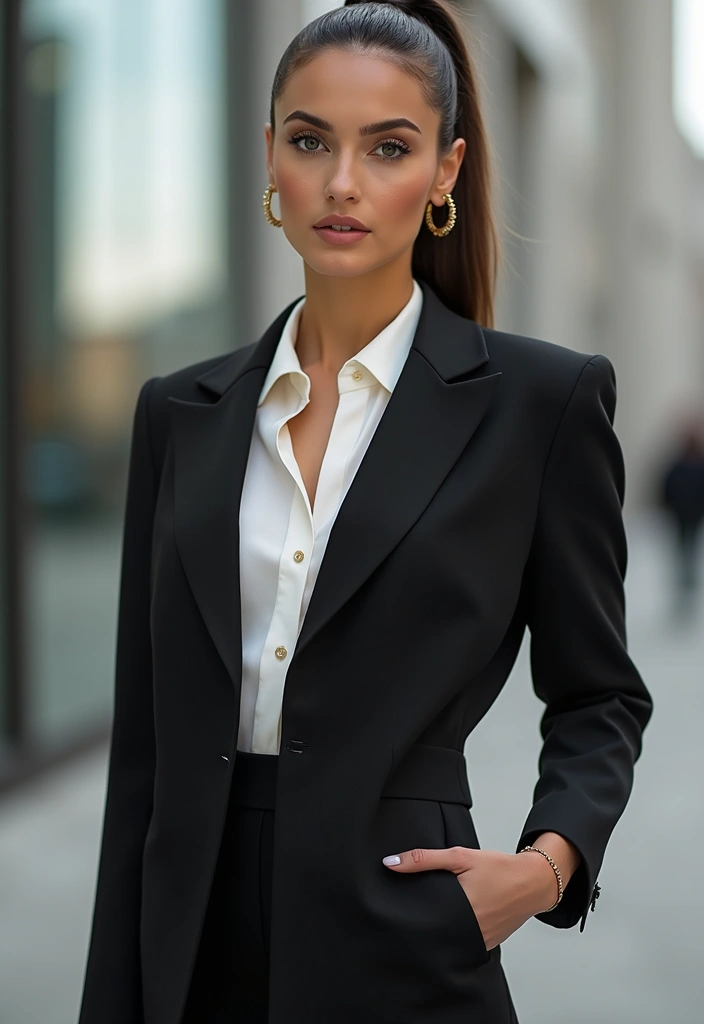
Thin hair on a round face can feel flat. A sleek ponytail with volume adds fullness and a polished edge.
– Step 1: Start with clean, dry hair and smooth a light serum through the lengths to tame flyaways. Use a light hand so you don’t weigh down your hair.
– Step 2: Lift the crown and tease small sections at the roots to create natural height. Keep the tease loose to avoid a stiff look.
– Step 3: Gather all hair high at or just above the crown into a tight ponytail. Check the height in the mirror and adjust before tying.
– Step 4: Brush the sides smooth and keep the top shiny for a clean, refined look. A quick brush over the crown helps smooth any flyaways.
– Step 5: Take a thin strand from the ponytail and wrap it around the base to hide the hair tie, then pin it in place. Secure the wrap with a small pin so it stays put.
– Step 6: Finish with a strong hold hairspray for lasting hold and a touch of shine spray if you want extra gloss. Lightly mist away from the face to avoid buildup.
Tip: If your hair runs fine, skip heavy products and focus on lightweight shine to keep the look airy.
Why this look helps a round face and thin hair
Teasing adds height at the crown, which visually elongates the face. Wrapping the base hides the elastic and keeps the style neat. A high ponytail creates length and a sleek silhouette.
Next steps
Practice at home and adjust the lift to suit your hair texture. Pair this style with bold earrings for a confident finish.
21. Fishtail Braid
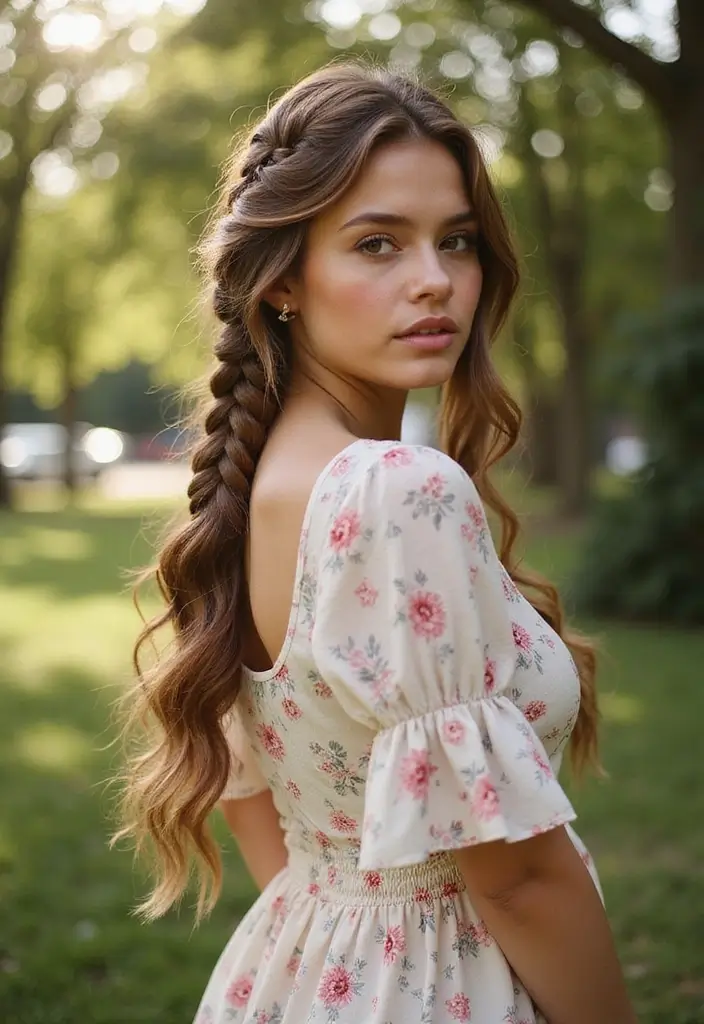
If you have a round face and thin hair, you want fullness that stays light. A fishtail braid gives texture and the look of thicker locks. Here is why this braid helps your round face.
What makes it work for you
– Small, tight strands add depth.
– The woven pattern creates volume at the crown.
– You can finish sleek or softly loose.
What you need
– A lightweight texturizing spray or mousse.
– A small hair tie.
– A mirror and a comb.
– Optional: a finishing spray.
How to do it
1) Add a touch of texture to help grip.
2) Part your hair where you want the fullness.
3) Start with two sections. Take a thin strand from the outer edge of the left and cross it over to the right. Then take from the outer edge of the right and cross it to the left.
4) Keep alternating a small strand until you reach the ends.
5) Secure with the elastic. If you want a softer look, gently pull on the braid to loosen it.
6) Finish with a light spray and tuck loose pieces for a natural frame around your face.
Why it suits a round face
– The vertical lines lengthen the face.
– Texture adds fullness without extra bulk.
Next steps
– Try a loose strand around the face for a soft frame.
– Pair with simple jewelry for a day to night look.
22. Twisted Half-Up
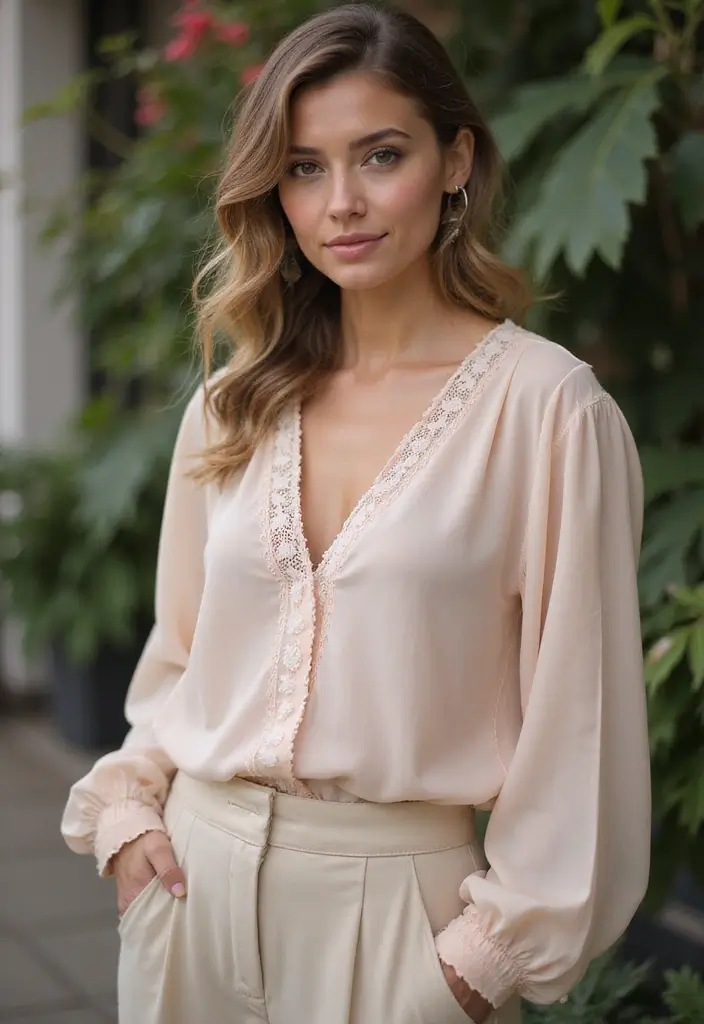
If you want more fullness around a round face, this twist helps. The twisted half-up brings height at the crown and keeps hair away from your cheeks. It looks polished but stays soft.
Here is why it works: twisting small sections back creates lift where your hair falls flat. The result is a smoother silhouette that adds volume without weighing hair down.
Next steps to pull it off:
1) Prep with a light root-lift product.
2) Section the top half of your hair.
3) Twist each section away from your face.
4) Bring the twists to meet at the back of your head. Pin them with two slim pins or wrap a tiny clear elastic to secure.
5) Adjust the height. If your hair falls forward, lift the crown a touch with your fingers and smooth the sides.
6) Finish with a light mist. A gentle spray keeps the look in place without stiffness.
Tips:
– For extra fullness, tease the crown a little before twisting.
– You can swap pins for a slim barrette for a dressier touch.
– This style works from casual days to formal events.
With a little practice, you can adjust the twists to fit your hair texture. This keeps the look comfy and reliable all day.
Elevate your hairstyle game! A twisted half-up not only adds fullness around a round face but also creates a chic silhouette that draws the eye upwards. Embrace the lift and let your hair shine!
23. Low Chignon with Face Framing Layers

Low Chignon with Face Framing Layers
If you have a round face and thin hair, this low chignon adds fullness without losing polish. The trick is soft face framing layers. They keep the top from looking flat while the back stays smooth. You can wear it for special events, work, or a classy night out.
Here is why it works: layers around the temples soften the cheeks. The bun sits low at the nape and stays secure. A touch of spray adds hold without stiffness, plus a few loose strands give a gentle, modern vibe.
Next, a simple how-to:
– Prep with a light mousse. Rough dry to lift the roots.
– Part where you like and lift the crown a touch for volume.
– Gather hair at the nape and twist into a bun. Pin it snugly.
– Optional: add a small donut for extra fullness or pull out a few wisps around the face.
– Finish: spray lightly and smooth any fly-aways.
Here are quick tips to make it work for you: keep the face-framing layers soft and just below your cheekbones. If you have very fine hair, tease slightly at the crown before forming the bun. With practice, you can adjust height and texture to fit your style.
Next steps: try different lengths of face-framing layers to see what makes your face look its best.
With a low chignon and soft face-framing layers, you can effortlessly add fullness to thin hair on a round face while keeping it classy for any occasion!
24. Romantic Twists
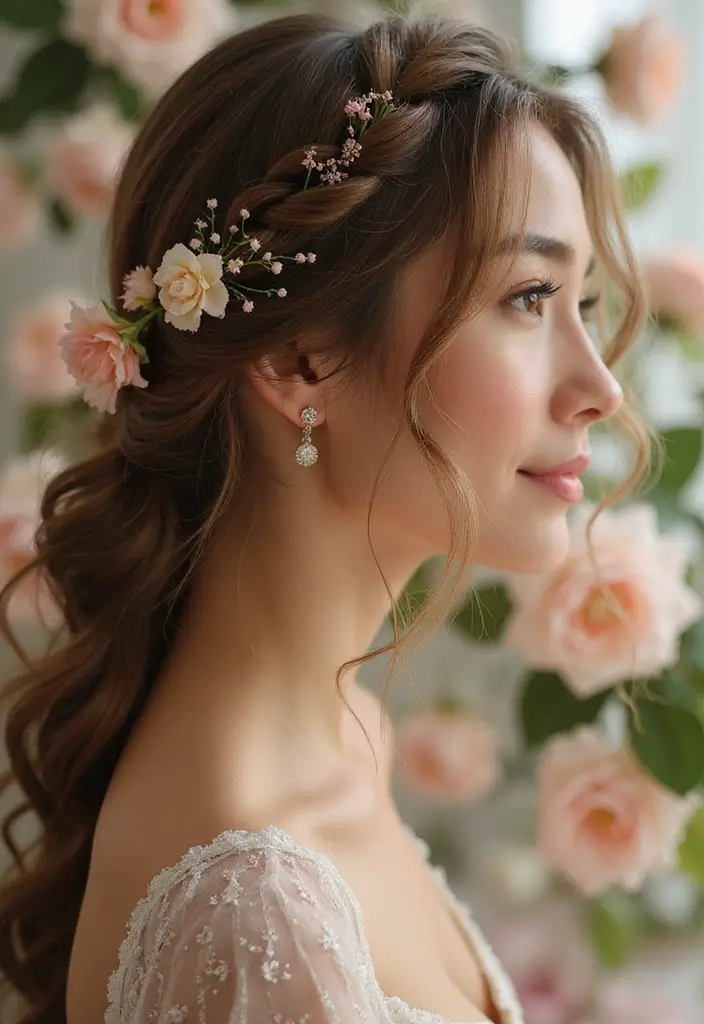
Are you hoping to add fullness to thin hair on a round face? Romantic twists can lift your look without heavy styling. This style twists small sections of hair away from the face and pins them at the back for a soft, dreamy feel.
Here is how to do it.
– Part your hair where you like it most. A side part often works well for balance.
– Take two small sections near the temples. Twist them back and secure with a discreet bobby pin just behind the crown.
– Let a few strands fall free along your cheeks. These bits frame your face and help reduce roundness.
– If you have very fine hair, mist a light texturizing spray from roots to ends. Then lift the crown with your fingers as you pin.
Tip: Finish with gentle waves or curls on the loose pieces. The texture catches light and creates the illusion of more volume.
Next steps? This look shines at weddings, dates, or any event where you want to feel special. You can switch it up by doing a single twist on one side for a chic asymmetrical style, or pair two side twists for a fuller crown. A light mist and a gentle spray keeps it in place all day.
25. Pompadour with Bangs
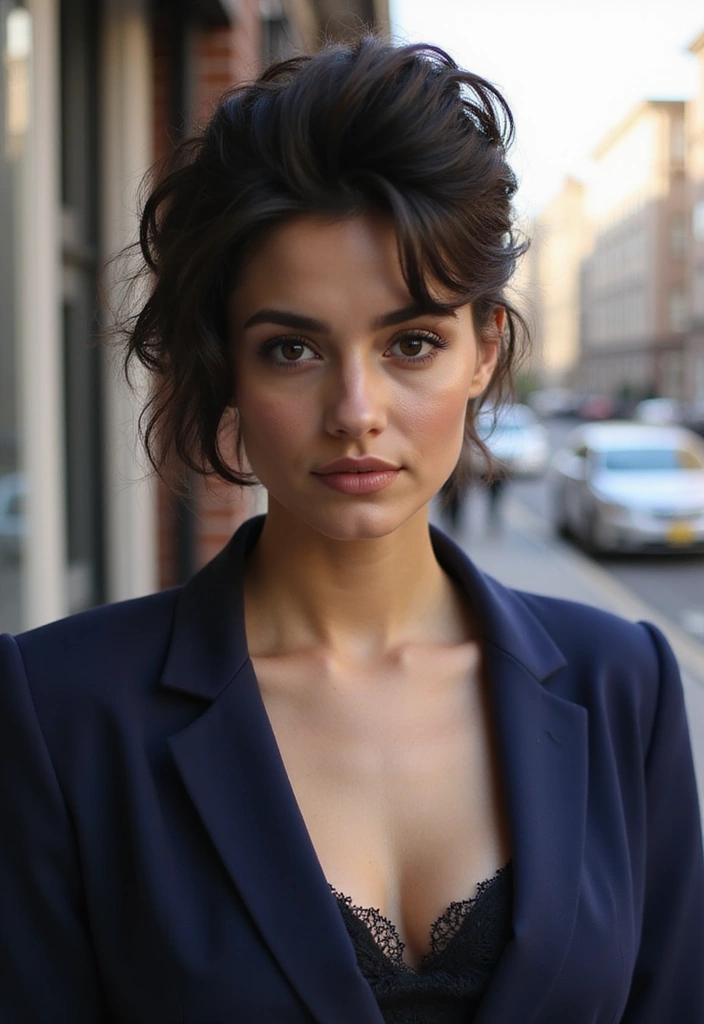
If you have thin hair and a round face, you want lift that lasts. A pompadour with bangs adds height and softens the edges. It looks bold and neat for nights out or special events.
Here is why it works: the upturned crown draws the eye upward, while the bangs frame your eyes and smooth the jawline. The balance helps your face look longer and less round.
– Start with dry hair to help the look hold.
– Tease the crown with a fine comb to create real volume.
– Smooth the top to keep the lift neat and controlled.
– Style the bangs to frame your eyes and soften the jaw. Side-swept bangs work well for round faces.
– Set the look with a small amount of strong-hold product. Work it through with your fingers for a natural finish.
– Lock in place with a light mist of hairspray or a matte finish product so it won’t weigh hair down.
Tip: Use a strong-hold product to keep it in place while avoiding flatness. This hairstyle is a great choice for nights out or special events where you want to turn heads!
Conclusion
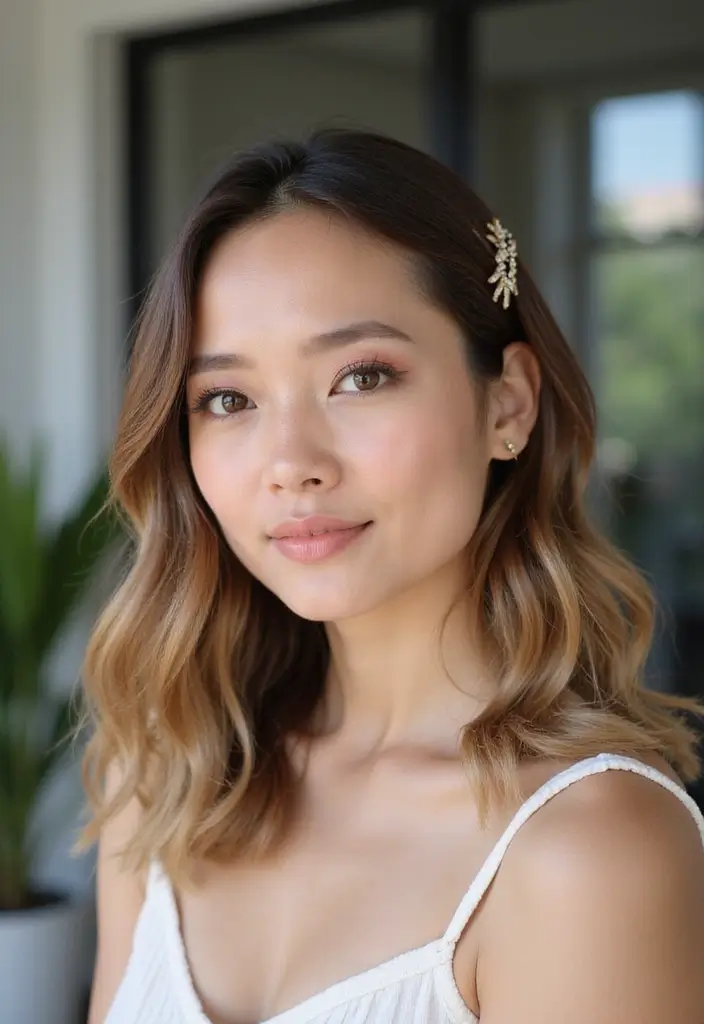
With these 25 hairstyles tailored for thin hair and a round face, you’ve got a variety of stunning options at your fingertips. Whether it’s layers, bangs, or playful textures, each style has the potential to elevate your look and enhance your natural beauty.
Don’t hesitate to experiment and find what resonates best with your style, and remember to have fun with your hair! Let’s celebrate the beauty of thin hair together and rock those looks with confidence.
Frequently Asked Questions
What are the best hairstyles for thin hair on a round face?
Some of the best hairstyles for thin hair on a round face include the layered bob, shaggy lob, and textured pixie cut. These styles add volume and frame your face beautifully, enhancing your features without making your hair look flat. Each of these hairstyles incorporates layers or texture, which helps to create the illusion of fullness.
Can bangs really help add fullness to thin hair on a round face?
Absolutely! Bangs can be a game-changer for thin hair on a round face. Styles like long soft bangs and curtain bangs can create the illusion of more volume while also framing your face. They draw attention to your eyes and soften the roundness of your face, making it look more balanced and flattering.
What are some volumizing hairstyles for thin hair?
Volumizing hairstyles for thin hair include wavy shoulder-length hair, beachy waves, and messy buns. These styles add texture and movement, making your hair appear thicker. Techniques like texturizing and using the right hair products can also enhance volume. Remember, the right cut can make all the difference!
How can I maintain volume in my thin hair throughout the day?
To maintain volume in your thin hair, start with the right hair products like volumizing mousse or root-lifting spray. Additionally, consider regular trims to keep your ends healthy and prevent flatness. Using a round brush while blow-drying can also help lift the roots, and incorporating dry shampoo can add texture and volume between washes.
Are there specific hair volume techniques I should try for thin hair?
Definitely! Some effective hair volume techniques for thin hair include layering, which helps to create movement, and texturizing the hair to avoid a flat look. You can also try backcombing at the roots for extra lift. Remember to use a light touch to avoid damage and keep your style looking fresh and natural.
Related Topics
hairstyles for thin hair
round face hairstyles
volumizing techniques
layered bob
shaggy lob
bangs styles
textured pixie
easy hairstyles
medium length hair
beachy waves
messy bun
romantic updos



















